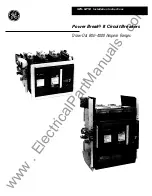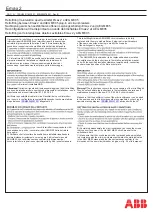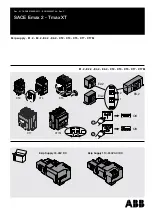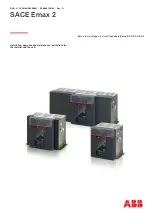
Maintenance
Vacuum Integrity Test Procedure
1. Observe safety precautions listed in the danger and cau-
tion advisories. Construct the proper barrier and warn-
ing light system.
2. Ground each pole not under test.
3. Apply test voltage across each pole for one (1) minute.
4. If the pole sustains the test voltage for that period, its
vacuum integrity has been verified.
Note: This test includes not only the vacuum interrupter,
but also the other insulation components in parallel with
the interrupter. These include the standoff insulators and
the insulated drive links, as well as the insulating (tension)
struts between the vacuum interrupter (polehead) supports.
If these insulation components are contaminated or defec-
tive, the test voltage will not be sustained. If so, clean or
replace the affected components, and retest.
If DC high potential tests are used, note the following: If a
DC test indicates loss of vacuum, reverse the polarity of
the test leads and retest. If the second test is successful,
the interrupter has adequate vacuum integrity. If the sec-
ond test also indicates loss of vacuum integrity, replace
the interrupter.
As-Found Insulation and Contact Resistance Tests - As-
Found tests verify the integrity of the breaker insulation
system. Megger or insulation resistance tests conducted
on equipment prior to installation provide a basis of future
comparison to detect changes in the protection afforded
by the insulation system. A permanent record of periodic
As-Found tests enables the Maintenance organization to
determine when corrective actions are required by watch-
ing for significant deterioration in insulation resistance, or
increase in contact resistance.
Insulation and Contact Resistance Test Equipment - In ad-
dition to the High Potential Test Equipment capable of test
voltages as listed in Table 4, the following equipment is
also required:
•
AC High Potential tester with test voltage of 1125 volts,
60 Hz.
•
Micro-Ohmmeter for contact resistance tests.
Insulation and Contact Resistance Test Procedure
1. Observe safety precautions listed in the danger and cau-
tion advisories for the Vacuum Integrity Check tests.
2. Close the circuit breaker. Ground each pole not under
test. Use manual charging, closing and tripping proce-
dures.
3. Apply the proper AC (i.e., either 37.5 or 45kV) or DC (i.e.,
either 53 or 63.6kV) high potential test voltage between
a primary conductor of the pole and ground for one
minute.
4. If no disruptive discharge occurs, the insulation system
is satisfactory.
5. After test completion, ground both ends and the middle
ring (if visible) of the vacuum interrupter to dissipate
any static charges.
6. Disconnect the leads to the spring charging motor.
7. Connect all points of the operator terminal block (lo-
cated on the right side of the operator frame) with a
shorting wire. Connect the shorting wire to the high
potential lead of the high voltage tester, and ground the
breaker housing. Starting with zero volts, gradually in-
crease the test voltage to 1125 volts, rms, 60 Hz. Main-
tain test voltage for one (1 ) minute.
8. If no disruptive discharge occurs, the secondary con-
trol insulation level is satisfactory.
9. Disconnect the shorting wire and reattach the leads to
the spring charging motor.
10. Perform contact resistance tests of the primary contacts
using a Micro-Ohmmeter. Contact resistance should not
exceed the values listed in Table 5. Note, the contact
resistance is measured across the phase terminals (out-
side terminals of roof bushings.)
11. Make a permanent record of all tests performed.
1200
150
2000
150
Table 5. Maximum Contact Resistance
Current Rating
(Amps)
Contact Resistance
(Micro-Ohms)
27






































